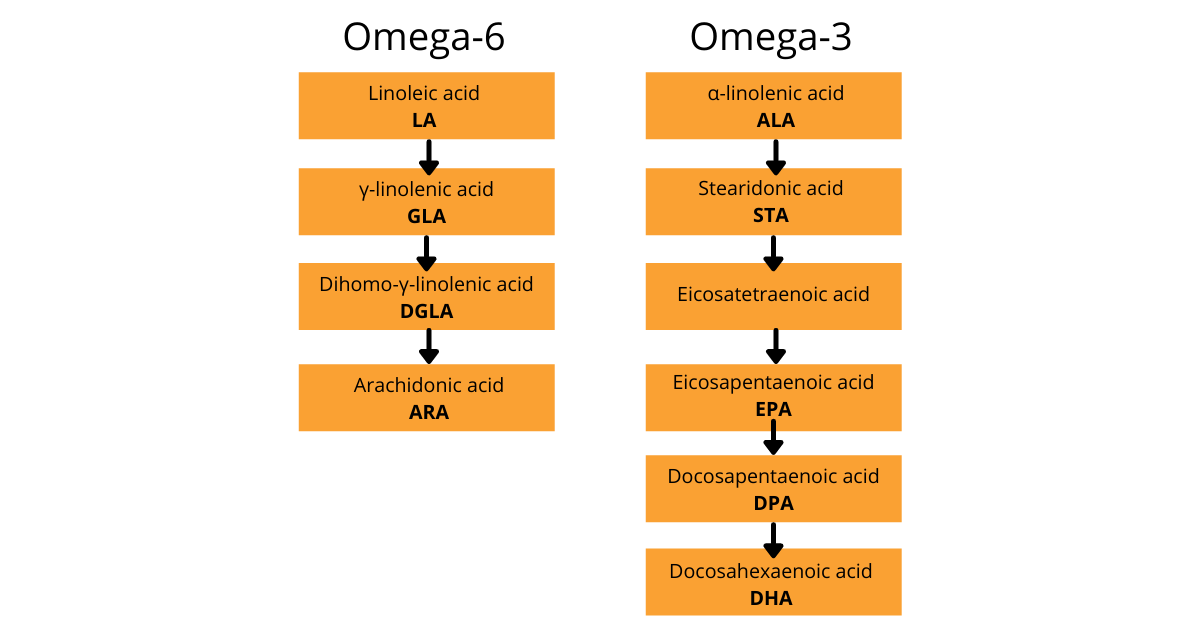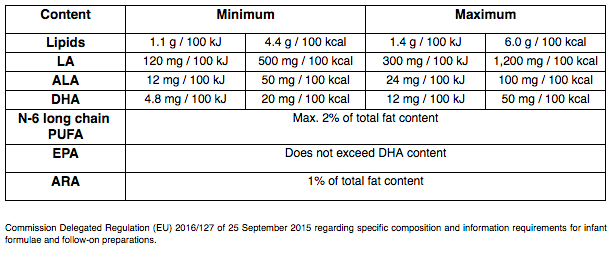Omega-3 and 6, essential for early life development

Essential fatty acids are part of the lipid family. Also called “fats”, lipids together with proteins and carbohydrates constitute one of the three major families of macronutrients. They are essential for the proper bodily function of adults and children alike.
In this article, find out about sources of fatty acids, different types and nutritional recommendations. You can also find information on the roles Omega-3 and 6 play in children’s development.
Precursors to PUFAs (polyunsaturated fatty acids)
Lipids come mainly in two forms: triglycerides and phospholipids. The latter consist primarily of fatty acids provided by food, whilst others are synthesised by our bodies. An essential fatty acid is a fatty acid that cannot be synthesised by our bodies and that requires exogenous intake through food. In the other case, when the body is able to synthesise fatty acids itself, they are termed non-essential.
There are two broad families of essential polyunsaturated fatty acids:
- Omega-3, the essential precursor of which is alpha-linolenic acid (ALA), which synthesises eicosapentaenoic acid (EPA) and docosahexaenoic acid (DHA). However, DHA is considered essential because it cannot be synthesised in sufficient quantities by the body even in the presence of ALA [1].
- Omega-6, with linoleic acid (LA) as a precursor enabling the body to synthesise arachidonic acid (ARA) [1].
In parallel, non-essential fatty acids include monounsaturated fatty acids such as oleic acid, and saturated fatty acids such as lauric, myristic and palmitic acids.

Why are fatty acids essential for proper infant development?
Omega-3 and 6 fatty acids are present in cell membranes. They play a role in organ and tissue function.
Omega and brain development
PUFAs, particularly DHA, are major components of neurons. They are therefore necessary for proper brain development in neonates.
DHA will accumulate mainly in the foetal brain, primarily during the third trimester of pregnancy.
Several studies highlight the importance of an essential fatty acids intake during pregnancy, particularly omega-3, for the cognitive development of neonates [14] [7].
During early life after babies are born, omega-3 and 6 requirements are supplied in breast milk, the DHA composition of which varies considerably depending on the mother’s diet [14]. Numerous clinical studies show that if the baby is not breastfed, supplementation of baby formulas with DHA may be beneficial for its neurodevelopment [17]. The addition of DHA has furthermore been mandatory in infant formulas since 2020. [15]
Importance of a balanced omega-6/omega-3 ratio
The amount of DHA that the body can produce from ALA is limited, in part by the omega-6/omega-3 ratio linked to competition for the enzymes which contribute to DHA and ARA synthesis.
A clinical investigation conducted in 2000 showed that to increase the capacity to synthesise DHA from ALA, consumption of an infant formula with a 5:1 ratio resulted in a higher concentration of DHA in blood and blood tissues compared to a formula with a 15:1 ratio. It is therefore important to maintain an ALA/LA ratio approaching 5 in order to improve endogenous DHA synthesis [16].
European standards for early life nutrition
Sources of omega-3 and omega-6
The primary source of polyunsaturated fatty acids (PUFAs) for children is breastfeeding. This is why exclusive breastfeeding is recommended for the first 6 months of life. In Europe, it is mandatory to enrich infant formulas. The regulation concerning infant formula specifies a total lipid content and also governs the composition of certain specific fatty acids such as LA, ALA and DHA [15]. After reaching 6 months old, babies are able to use precursors to form PUFAs naturally.
European regulations for infant formula

Since 2020, infant formulas designed for the first 6 months of life, and follow-on preparations, must contain doses of DHA between 20 and 50 mg/100 kcal. [15]
Omega-3 and 6 are essential for proper children’s development. From an early age, they enable proper neurological development [17] to take place, and also play a part in many other physiological functions.
SOURCES:
[1] Les lipides – Anses – Mars 2021
[2] Simopoulos AP. The importance of the omega-6/omega-3 fatty acid ratio in cardiovascular disease and other chronic diseases. Exp Biol Med (Maywood). 2008 Jun;233(6):674-88. doi: 10.3181/0711-MR-311. Epub 2008 Apr 11. PMID: 18408140.
[3] Simopoulos AP. An Increase in the Omega-6/Omega-3 Fatty Acid Ratio Increases the Risk for Obesity. Nutrients. 2016 Mar 2;8(3):128. doi: 10.3390/nu8030128. PMID: 26950145; PMCID: PMC4808858.
[4] Shetty SS, Kumari N S, Shetty PK. ω-6/ω-3 fatty acid ratio as an essential predictive biomarker in the management of type 2 diabetes mellitus. Nutrition. 2020 Nov-Dec;79-80:110968. doi: 10.1016/j.nut.2020.110968. Epub 2020 Aug 7. PMID: 32919185.
[5] A. Houlbert ; La meilleure façon de manger (Thierry Souccar éditions)
[6] Acides gras de la famille oméga 3 et système cardiovasculaire – Anses
[7] Acides gras polyinsaturés oméga-3 et leurs bienfaits pour la santé – F. Shahidi et P. Ambigaipalan – Revue annuelle des sciences et technologies alimentaires 2018 9 : 1 , 345-381
[8] INSERM. (2020, 10 décembre). Lien entre nutrition et cerveau – Inserm.
[9] CLÉMENTINE BOSCH-BOUJU, C. B.-B., & SOPHIE LAYÉ, S. L. (2015). FONCTIONNEMENT CÉRÉBRAL : LE RÔLE DES ACIDES GRAS POLYINSATURÉS. NUTRITION INFOS N° 42.
[10] Bocquet, A. (2021, 12 janvier). Les acides gras dans l’alimentation de bébé 0 – 3 ans.
[11] Gutiérrez, S., Svahn, SL et Johansson, ME (2019). Effets des acides gras oméga-3 sur les cellules immunitaires. Revue internationale des sciences moléculaires , 20 (20), 5028.
[12] Czernichow, Sébastien ; Thomas, Daniel ; Bruckert, Eric ; Acides gras oméga-6 et maladies cardiovasculaires : Recommandations en matière d’apport alimentaire, Med Sci (Paris), 2011, Vol. 27, N° 6-7 ; p. 614-618 ; DOI : 10.1051/medsci/2011276013
[13] Les acides gras oméga 3 | Anses – Agence nationale de sécurité sanitaire de l’alimentation, de l’environnement et du travail. (s. d.). Anses.
[14] Shulkin, M., L. Pimpin, D. Bellinger, S. Kranz, W. Fawzi, C. Duggan, et D. Mozaffarian. 2018. “n-3 Fatty Acid Supplementation in Mothers, Preterm Infants, and Term Infants and Childhood Psychomotor and Visual Development: A Systematic Review and Meta-Analysis.” J Nutr 148 (3):409-418. doi: 10.1093/jn/nxx031.
[15] Règlement européen : EU 2016/127
[16] Markrides M, Neumann MA, Jeffrey B, Lien E, Gibson R. A randomized trial of different ratios of linoleic to α-linolenic acid in the diet of term infants : effects on visual function and growth. American Journal of Clinical Nutrition. 2000; 71:120-9
[17] EFSA NDA Panel (EFSA Panel on Dietetic Products, Nutrition and Allergies), 2014. Scientific Opinion on the essential composition of infant and follow-on formulae. EFSA Journal 2014;12(7):3760, 106 pp. doi:10.2903/j.efsa.2014.3760










